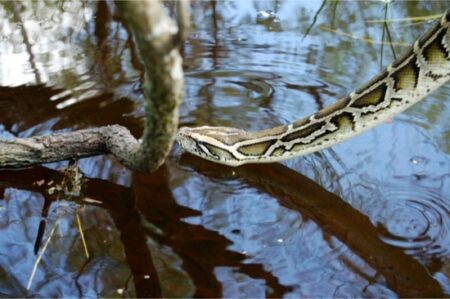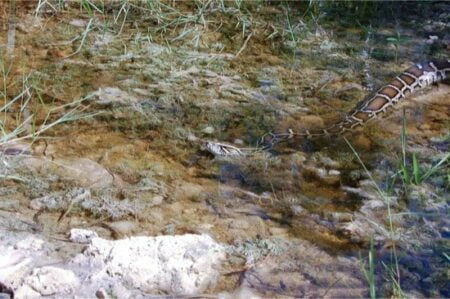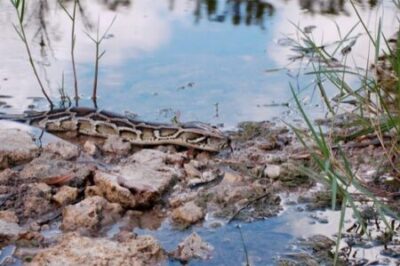The Burmese python is a huge snake that’s native to Asia. However, these powerful constrictor snakes have started to colonize certain parts of Florida. So, how did they get there, and why are they thriving in an area that’s thousands of miles away from their natural ecological range?
A small number of Burmese pythons were set free by irresponsible owners who sought to abandon their pets. Also, Hurricane Andrew damaged breeding facilities in 1992, which released several hundred Burmese pythons into the wild. These became a breeding population, which has thrived in Florida’s warm and hospitable climate.
Scientists and hunters want to cull the population of Burmese pythons. These snakes are a major threat to the natural ecosystem of the Everglades, and are putting endangered species at risk. So far, they have had some success, but exact population figures remain unknown.
Burmese Python in Florida Facts
The Burmese python is a very long, heavy constrictor snake. Their scientific name is Python bivittatus, ‘bivittatus’ coming from the Latin for ‘two stripes.’ Rather than being striped snakes, they have dark brown blotches all along their back. These are bordered by black scales, and are on a lighter brown or tan background. The ‘two stripes’ refers to the two stripes on their head, rather than their back.
In their native land, they’re an endangered species. But in the U.S., they’re kept as pets by some people. Unfortunately, many snake owners who bought them during their initial popularity realized that they couldn’t take care of one. According to National Geographic, they can grow to longer than 23 feet, and can weigh 200 pounds. This led to people releasing them to the wild, where they began a breeding population in the Florida Everglades.
Let’s start by looking at how Burmese pythons managed to get all the way from southeast Asia, over to Florida, and how they managed to form a breeding population so far away from home.
Where Did the Burmese Python Originally Come From?
The Burmese python comes from Myanmar. It is between Thailand to the south and east, China to the north and east, and Bangladesh/India to the west. It’s a beautiful part of the world, with mountains to the north, the Bay of Bengal to the south, and rainforest and jungle in between. Burmese pythons can be found in ecologically similar regions all across southeast Asia, too (e.g. China, Vietnam, Laos, Thailand, etc).
This is the Burmese python’s natural habitat. They’re semi-aquatic, and need a permanent source of nearby water. Because of the diversity of their geographical range, you can find them in marshes and swamps, hills, woodland, and jungles. This ability to colonize a variety of habitats, plus their need for water, is what is driving their success as an invasive species in Florida.
Are Burmese Pythons Legal in Florida?
Burmese pythons are legal in Florida, if you have the correct license for your pet. Recent additions to the state law of Florida have tightened regulations on animals like the Burmese python.
In June 2010, Bill CS/SB 318 passed which amended Chapter 379 of the Florida Statutes. Under the amended section 379.372, many additions were made to the list of animals that can’t be possessed, imported, sold, bartered, traded or bred in Florida without a license from the FWC (Fish and Wildlife Conservation Commission).
Under the amended section 379.4015, a minimum fine of $100 applies for keeping one without the correct permit. The animal would also be confiscated. The only exception to these rules is when animals are kept for scientific research, which does require a permit, but the permit is free.
How Did Burmese Pythons Reach the Everglades?
There are two main theories as to how the initial population started. Towards the end of the twentieth century, sightings of Burmese pythons began—from the late 1980s onwards. This was just as Burmese pythons started taking off as a pet, and like all pets, are sometimes some abandoned.
Now, this wouldn’t have been enough to start the population trends we see today. When there are less than a dozen or so animals of a particular species in the wild, they can’t find each other easily, and therefore can’t mate and increase the population easily. But that all changed in 1992 when Hurricane Andrew hit Florida.

Hurricane Andrew caused mass destruction—it was the worst hurricane ever to hit Florida, until Hurricane Irma came along 25 years later. It generated a total of $27.3 billion in damage. What seems to have happened is that Hurricane Andrew damaged local breeding facilities, which let more than a hundred Burmese pythons free, all at once.
Since then, their population has grown significantly. Because their native habitat is quite similar to the Everglades, they’ve been able to continue breeding ever since. Hunters and scientists have tried their best to limit how many there are in the wild. However, their methods so far have only had a limited impact. Their population is bigger than ever, ironically at a time when their numbers in southeast Asia are decreasing.
How Many Burmese Pythons Are in Florida?
It’s not clear how many Burmese pythons there are in the Everglades. They’re difficult to spot in the undergrowth or hiding in trees, and the Everglades is a big place. The U.S. Geological Survey believes there to be tens of thousands of Burmese pythons living in the Everglades. This number is based on studies in select areas, as well as population trends.
In 2018, scientists figured out a way to track down groups of males and females called aggregations. This is where a group of male snakes is all competing for the attention of a nearby female. Scientists captured and released a snake they nicknamed Argo, having fitted him with a tracking chip. They tracked him for a few days before finding him with a 100lb female that was just about to lay her clutch. Releasing him again, three days later, they found him with a 115lb female and seven other males.
Why Are Burmese Pythons a Problem to Florida?
Burmese pythons aren’t a ‘problem’ in themselves. They’re just an animal doing what it does best: hunting, eating, and mating.
But invasive species are a problem. Flora and fauna interact in ways that we don’t fully understand. But what we do understand is that by altering one part of an ecosystem, the rest changes too—and is, perhaps, even destroyed. This is inconceivable to anybody who lives near a national park, or similarly protected habitat. Because once it’s gone, it’s gone.
Burmese pythons have so far begun to populate the Florida Everglades, which are quite similar to their native habitat. They’re thriving, and their population is increasing rapidly. At the same time, the Everglades themselves are disappearing.
Only 25% of the original Florida Everglades still survives. Politicians have taken steps to protect it, by creating the Everglades National Park. It’s threatened by many issues, including water drainage, nitrates, and mercury entering the ecosystem, urban encroachment, and now invasive species.
How Does the Burmese Python Affect the Ecosystem?
According to the Independent newspaper, Burmese pythons have been responsible for rendering many local species practically extinct. Scientists think that 90 percent or more of the fauna that used to inhabit the Everglades are now gone. That means that there are 90% fewer individual animals living there today than there were since the turn of the century.
They’ve also affected certain animals more so than others. Foxes and rabbits have already disappeared. Raccoons populations are down 99.3%, and opossum populations are down by 98.9%. White-tailed deer have also practically disappeared, with populations 94.1% lower than they were.

The National Academy of Sciences has stated that they’re affecting unique species, too. They described how the increase in the number of Burmese pythons was threatening alligators and Florida panthers with extinction. Burmese pythons are also threatening the following threatened species:
- Piping plovers
- Everglades snail kites
- Wood storks
- Red-cockaded woodpeckers
- Coyotes
Burmese pythons feed on 39 endangered species and 41 other rare species. If we don’t act soon, then all of these animals could disappear.
Apex Predators
Burmese pythons are very large snakes. They can reach upwards of 23 feet, and weigh 200lbs. For reference, that’s as big as a telephone pole. We’re talking about a huge predator. This means that they’re bigger than anything else you can find in the Everglades, including alligators.
They’re also good hunters. Their natural camouflage prevents prey from being able to spot them. It also stops any predators from being able to find them, including humans. They can eat almost anything. In 2018, Orland Weekly reported that a Burmese python was found in the process of regurgitating a deer. This in itself isn’t unusual.
But what was special about this Burmese python was that it was trying to eat a snake that was bigger than itself. After they caught the snake, they weighed it—it was 31.5lbs, which isn’t that heavy for a long Burmese python. The deer it was eating (still a fawn) was 35lbs.
The point is that Burmese pythons can eat almost anything, and there isn’t an animal that can consistently threaten them. Even a crocodile isn’t likely to beat a Burmese python in a fight. Because they’re unchallenged, they can keep breeding, and their population keeps growing unchecked.
Quick Breeders
Burmese pythons are prolific breeders. They can lay 30 or more eggs at a time. Unlike most snakes, they protect their eggs from potential threats. This means that they can breed, lay eggs, and have them hatch. They can breed every year, between March and April.
Not only that, but they start reproducing when they’re very young compared to other animals. They begin breeding at three years old. You can have multiple generations of these snakes within just five years.

The problem is that the upper limit to their population is dictated by how much prey they can find. This is the upper limit of any animal population. This means that the population will keep growing, putting more pressure on the populations of prey animals, until the prey animals are all gone.
Natural Survivors
Burmese pythons are well camouflaged. If they can avoid hunters, a Burmese python in the Everglades can live for 15+ years. That’s a very long lifespan for a snake in the wild.
Why is that important? If they can mate every year, or every other year, then a female can have many clutches throughout her life. It’s unclear whether Burmese pythons mate every year in the wild, or take years off, but a female could have several clutches throughout her life. Considering that an average clutch is over 30 eggs, you can see how quickly the population could explode.
Interbred to Adapt
Scientists working with the USGS and Everglades National Park had been studying the population. In 2018, they published a study on their DNA, to see how they may have adapted to their new environment, and how they might be different from Burmese pythons back home.
What they found, shocked them. They discovered that many of the Burmese pythons they analyzed had interbred with Indian rock pythons. Of the 400 or so snakes they examined, 13 of them had traces of Indian rock python mitochondrial DNA, which is passed down the mother’s direct ancestral line. They theorized that this hadn’t happened since they’d been living in the Everglades, but had happened at some point in the past when the direct ancestors of these snakes had been in captivity.
Scientists think that their interbreeding has made them more adaptable. When two species interbreed, each has a unique set of traits that make them suitable for living in an environment. The offspring of these snakes will inherit the positive traits that help them adapt to their new habitat, while those that can’t adapt will die off. It’s natural selection at work.
How Can the Burmese Python Be Controlled?
It’s clear that something has to be done about the Burmese python as an invasive species. If we continue to allow them to roam free, the population will keep getting bigger, threatening more local species with extinction. So, how can they be stopped?
Rangers Hunting and Killing Them
Regular, controlled hunts help keep animal populations in check. It’s necessary to hunt Burmese pythons and try and prevent their population from growing any further.
And that’s exactly what hunters are doing. According to the National Post, a total of 1,825 Burmese pythons were found and killed between 2000 and 2011. Their news story was related to the biggest ever Burmese python found in Florida, which was 17 feet and 7 inches long. As if that wasn’t testament enough to the success of the invasive species, the snake was a female, and she was pregnant with 87 eggs.
Local authorities have encouraged the hunting and killing of Burmese pythons through bounties. Hunters are paid a flat rate of $8.10 an hour, but they also get a bounty based on the size of the snake they capture.
Hunters get paid $50 for a 4-foot snake, plus $25 for each extra foot. So, a 10-foot Burmese python could earn a hunter $200. Hunters also get $150 for a python that was nesting. 25 full-time hunters are working for local authorities, plus it’s legal for any private individual to join in.
Radiotelemetry Hunting
Remember what we said above about the snake they fitted with a chip, so they could follow it around and find more snakes? That’s radiotelemetry. Researchers at the University of Florida are working with the USGS, as well as the National Park Service and many other bodies, to control the population of Burmese pythons. They’ve been experimenting with radiotelemetry with great success.
Radiotelemetry helps them track down snakes in small groups. This is of great help to hunters, who can bag five snakes for the price of one. Aside from that, though, the researchers are also using it to learn more about the habitat they prefer, what they eat, and how they’re putting local species at risk. Their approach, quite rightly, is that the more we know about these snakes, the better chance we have of controlling them.
The only downside is that it’s a costly way to control the population. There’s the cost of the tracker itself. There’s also the fact that you have to repeatedly catch and release the snake, which takes man-hours. If this program could be expanded, it would be highly effective, but costs stand in the way.
Regulatory Measures
State legislators have tried to get a handle on the Burmese python problem by passing rules and regulations which should prevent their spread. The Florida Fish and Wildlife Commission created a regulation that requires anybody who owns a boa or python longer than 2 inches to have a permit.
Besides that, federal laws have made it illegal to import Burmese pythons. They were added to the Lacey Act, which prohibits trade in certain flora and fauna. As a side note, this is helpful for the Burmese python—in their natural southeast Asian habitat, their numbers are decreasing.
Chemical Control
Scientists have reviewed the efficacy of acetaminophen in controlling the Burmese python population. Acetaminophen is actually listed by the U.S. Environmental Protection Agency as a toxicant that kills brown tree snakes. By lacing dead prey with acetaminophen, the snakes are tricked into eating it, and quickly die. Laboratory trials suggest that Burmese pythons are susceptible.
However, there’s a good reason why using chemical control might not be a good option. It takes quite a lot of acetaminophen to kill a large python. If a non-target species were to eat the prey first—like an alligator—they would die instead. Scientists also have to make sure that endangered native snakes like the Indigo snake don’t eat the prey, for the same reason.
Biological Pest Control
Biological pest control is where we use a predator, parasite, fungus, or virus to kill off an unwelcome species. The most famous example is from recent history, when in 1995, scientists reintroduced wolves to Yellowstone National Park. They did so to manage the rising elk population, and they were exceptionally successful.
Scientists examining the problem have reviewed biological control as a potential method of getting rid of Burmese pythons. Perhaps the best idea is to use a virus that specifically affects Burmese pythons, but not native wildlife. Unfortunately, no such control method yet exists.

